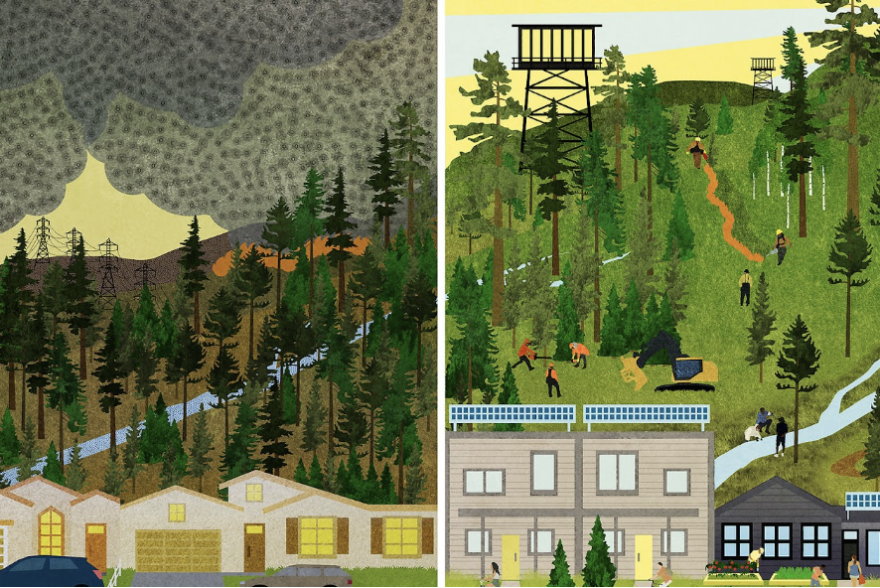High Roads to Resilience: Building equitable forest restoration economies in California and beyond


A recent report from Sara Nelson, Patrick Bigger, Micah Elias, and Andrew Schuldt in collaboration with the University of British Columbia’s Centre for Climate Justice, takes stock of the state of forest restoration governance, offering detailed recommendations to put communities, workers, and the land itself on a High Road to Resilience.
Written by: Micah Elias and BF Science Advisors Patrick Bigger, and Sara Nelson
Original report by: Sara Nelson and Patrick Bigger, Micah Elias, and Andrew Schuldt in collaboration with the University of British Columbia’s Centre for Climate Justice
California wildfires are emblematic of the climate crisis and a harbinger of a dangerous future without significant levels of forest restoration. The climate and ecological risks of the wildfire crisis are compounded by an equally vast set of social problems. These social problems date back to colonialization and the genocide of Indigenous peoples, followed by policies and management regimes which left rural communities degraded. The funding needed for forest restoration is vast and although state and federal funding is increasing, it is unclear whether money alone will enable the levels of restoration needed or foster a robust forest restoration economy in rural communities throughout California and the West.
A recent report from Sara Nelson, Patrick Bigger, Micah Elias, and Andrew Schuldt in collaboration with the University of British Columbia’s Centre for Climate Justice, takes stock of the state of forest restoration governance, offering detailed recommendations to put communities, workers, and the land itself on a High Road to Resilience. This pivotal moment is an opportunity for transformative forest management that is socially and ecologically restorative, not only reducing wildfire severity and enhancing forest resilience, but to sustain long-term employment and reinvigorate forest-based industries in areas that have suffered from the decline of the timber industry. This effort will require a diverse range of expertise, particularly Traditional Ecological Knowledge implemented by Indigenous practitioners according to principles of self-determination.
The qualitative and quantitative evidence in this report shows that effective climate policy must deliberately prioritize holistic, restorative solutions for both forests and communities. It is possible to envision a ‘low road’ approach to restoration that relies on lowest-cost labor, poor working conditions, and contracting decisions that send the economic benefits of restoration to far-away cities. But a high road approach to forest restoration is within reach by prioritizing benefits for disadvantaged communities, beginning to redress past harms, and offering workers livable wages in dignified working and living conditions. Doing so could create new industries in communities suffering the impacts of past economic decline, and deliver quality, long-term employment in diversified forest-based economies. The vision we offer here is a program of transformative, systemic investments in public lands and the communities that care for them.
This report offers findings across four main areas, with companion recommendations to put forest restoration on the high road:
-
First, California’s forest restoration funding offers essential resources, but key changes to the grant system, as well as increased transparency and accountability, are needed to ensure funds are supporting local workers and workforce development. Specific recommendations are offered to increase the flexibility in the use of state grant funds for forest restoration while developing non-competitive and coordinated funding approaches to a variety of forest restoration practitioners.
-
Second, labor shortages are being felt across the forest restoration sector as a result of low wages, difficult working conditions, loss of forestry knowledge due to industrial decline, and structural economic problems for rural communities. The recommendations on workforce center on building a more equitable forest restoration industry – especially by foregrounding partnerships with Tribes, improving opportunities for formerly incarcerated firefighters who want to work in restoration, and lifting all workers through improved wages, conditions, and training.
-
Third, limited US Forest Service (USFS) capacity poses challenges for implementing restoration work and building the workforce, and limits the effectiveness of new state and federal funding coming into the system. To rectify this situation, USFS should focus hiring efforts on key positions that maximize community and Tribal partnership, and improve capacity for permitting and monitoring restoration projects, while reevaluating contracting costs to better understand what capacities should be brought back in-house.
-
Finally, there are an array of structural political and economic factors that limit the pace and scale of forest restoration in ways that contribute to local economies. Rural and Indigenous communities disproportionately suffer the impacts of poverty, including limited access to housing, health care, transportation, and telecommunications, and increased exposure to the criminal justice system – all of which pose challenges in workforce development and equity for workers. Many of these issues can only be rectified through broad-based, investment-forward policy responses grounded in a holistic green industrial policy that can reshape public lands management and rural economic development.
Ultimately, this report lays out a roadmap for reinvestment in rural communities and landscapes by a range of stakeholders – including community nonprofits, Tribal organizations, and state and federal agencies – that can put forest restoration on the high road to a safer, more vibrant future in a warming world.